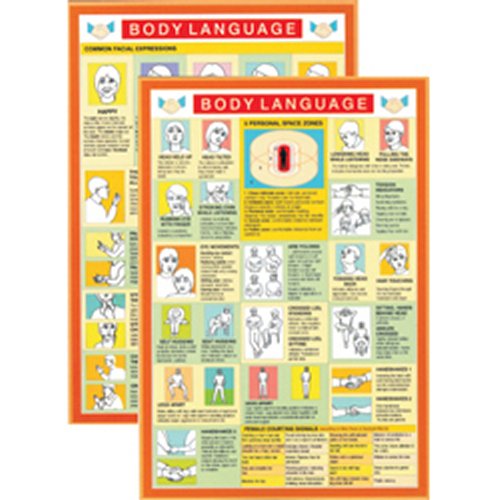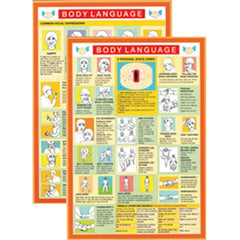

Body Language Mini Chart
- $9.95 USD
$11.95 USD- $9.95 USD
- Unit price
- per
Body language is a form of mental and physical ability of human non-verbal communication, which consists of body posture, gestures, facial expressions, and eye movements. Humans send and interpret such signals almost entirely subconsciously.
"Research has suggested that between 60 and 70 percent of all meaning is derived from nonverbal behavior."
Body language may provide clues as to the attitude or state of mind of a person. For example, it may indicate aggression, attentiveness, boredom, relaxed state, pleasure, amusement, and intoxication, among many other clues.
Physical expression
Physical expressions like waving, pointing, touching and slouching are all forms of nonverbal communication. The study of body movement and expression is known as kinesics. Humans move their bodies when communicating because, as research has shown it helps "ease the mental effort when communication is difficult." Physical expressions reveal many things about the person using them. For example, gestures can emphasize a point or relay a message, posture can reveal boredom or great interest, and touch can convey encouragement or caution.
Common Body Language Points to Look for in Others
- One of the most basic and powerful body-language signals is when a person crosses his or her arms across the chest. This can indicate that a person is putting up an unconscious barrier between themselves and others. However, it can also indicate that the person's arms are cold, which would be clarified by rubbing the arms or huddling. When the overall situation is amicable, it can mean that a person is thinking deeply about what is being discussed, but in a serious or confrontational situation, it can mean that a person is expressing opposition. This is especially so if the person is leaning away from the speaker. A harsh or blank facial expression often indicates outright hostility.
- Consistent eye contact can indicate that a person is thinking positively of what the speaker is saying. It can also mean that the other person doesn't trust the speaker enough to "take their eyes off" the speaker. Lack of eye contact can indicate negativity. On the other hand, individuals with anxiety disorders are often unable to make eye contact without discomfort. Eye contact can also be a secondary and misleading gesture because cultural norms about it vary widely. If a person is looking at you, but is making the arms-across-chest signal, the eye contact could be indicative that something is bothering the person, and that he wants to talk about it. Or if while making direct eye contact, a person is fiddling with something, even while directly looking at you, it could indicate that the attention is elsewhere. Also, there are three standard areas that a person will look which represent different states of being. If the person looks from one eye to the other, then to the forehead, it is a sign that they are taking an authoritative position. If they move from one eye to the other, then to the nose, that signals that they are engaging in what they consider to be a "level conversation" with neither party holding superiority. The last case is from one eye to the other and then down to the lips. This is a strong indication of romantic feelings.
- Disbelief is often indicated by averted gaze, or by touching the ear or scratching the chin. When a person is not being convinced by what someone is saying, the attention invariably wanders, and the eyes will stare away for an extended period.
- Boredom is indicated by the head tilting to one side, or by the eyes looking straight at the speaker but becoming slightly unfocused. A head tilt may also indicate a sore neck, trust or a feeling of safety (part of the neck becomes uncovered, hence vulnerable; It's virtually impossible to tilt our head in front of someone we don't trust or are scared of) or Amblyopia, and unfocused eyes may indicate ocular problems in the listener.
- Interest can be indicated through posture or extended eye contact, such as standing and listening properly.
- Deceit or the act of withholding information can sometimes be indicated by touching the face during conversation. Excessive blinking is a well-known indicator of someone who is lying. Recently, evidence has surfaced that the absence of blinking can also represent lying as a more reliable factor than excessive blinking.
Some people use and understand body language differently, or not at all. Interpreting their gestures and facial expressions (or lack thereof) in the context of normal body language usually leads to misunderstandings and misinterpretations (especially if body language is given priority over spoken language). It should also be stated that people from different cultures can interpretate body language in different ways.
Many of these issues are discussed in point form in this informative mini chart.
The chart is double sided. The chart is richly illustrated and is protection coated on both sides. The chart measures 9.25 x 6.25" (235 x 160mm) in size.
Note: The low resolution image shown has been purposely provided to protect copyright content of the chart. The chart you will receive is in an easy to read high resolution format.
Returns Policy
You may return most new, unopened items within 30 days of delivery for a full refund. We'll also pay the return shipping costs if the return is a result of our error (you received an incorrect or defective item, etc.).
You should expect to receive your refund within four weeks of giving your package to the return shipper, however, in many cases you will receive a refund more quickly. This time period includes the transit time for us to receive your return from the shipper (5 to 10 business days), the time it takes us to process your return once we receive it (3 to 5 business days), and the time it takes your bank to process our refund request (5 to 10 business days).
If you need to return an item, simply login to your account, view the order using the "Complete Orders" link under the My Account menu and click the Return Item(s) button. We'll notify you via e-mail of your refund once we've received and processed the returned item.
Shipping
We can ship to virtually any address in the world. Note that there are restrictions on some products, and some products cannot be shipped to international destinations.
When you place an order, we will estimate shipping and delivery dates for you based on the availability of your items and the shipping options you choose. Depending on the shipping provider you choose, shipping date estimates may appear on the shipping quotes page.
Please also note that the shipping rates for many items we sell are weight-based. The weight of any such item can be found on its detail page. To reflect the policies of the shipping companies we use, all weights will be rounded up to the next full pound.
Related Products
- Choosing a selection results in a full page refresh.

